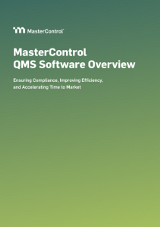
GxP Lifeline
The EQMS for Your Quality Assurance and Quality Control Systems
We talk about quality a lot, but when it comes to day-to-day work, what does quality look like? In most organizations, quality comes down to quality assurance and quality control with different tasks falling under each category. Understanding both is essential, but so is ensuring these different tasks are done correctly.
A good quality system needs to ensure effective communication between QA and QC. The best way to do this is with an electronic quality management system (eQMS). Both roles can use an EQMS to perform their functions and ensure that everyone is on the same page when it comes to quality.
eQMS Applications to the Quality System
Increasingly more organizations have begun to understand how an optimal eQMS can ensure that each product meets specific efficacy, safety, quality, and compliance requirements. A robust eQMS will automate, monitor, and effectively manage all core quality assurance and quality control processes, including:
Quality audits
An eQMS will streamline and better manage the entire audit process, from scheduling and planning through execution and completion; automate scheduling of all recurring audit-related activities; and leverage advanced tracking, analytics, and reporting capabilities for a real-time view of the audit process.Quality events
An eQMS will enable you to more effectively identify, evaluate, and handle nonconformances, deviations, customer complaints, and other quality events; automate data collection, routing, follow-up, and escalation of quality events; and leverage forms and processes that connect personnel for quick disposition of a nonconformance.Corrective actions/preventive actions (CAPAs)
An eQMS with strong CAPA capabilities will automate and more effectively manage every step of CAPA implementation, from identification of the problem through corrective action; integrate the CAPA process with other quality processes, such as nonconformance and audit; and help keep your quality system always ready for inspections and audits.Change control
An end-to-end eQMS will allow you to streamline the entire change control process and quality control system; leverage forms that incorporate priority level and prompt risk assessment and classification of the change; and customize reports that will provide real-time status of change control tasks as well as the entire quality system.Document control
An eQMS with robust document management abilities will enable you to automate and better manage all tasks relating to documents-based processes; maintain all documentation in a single repository; and integrate quality processes like CAPA and audits.Training management
A robust eQMS will automate the assigning and monitoring of training tasks; and integrate training management with the rest of the quality control system, so any change to a quality document or process that requires new training will automatically prompt training tasks upon approval of the change.Risk
An integrated eQMS can help organizations identify and mitigate long-term systemic risks by tracking and analyzing the recurrence of issues; unify all risk-related activities and documentation in a single, centralized repository; automatically receive information (about a deviation, for example) that triggers a risk analysis; and gain a complete view of risk across product lines, business processes, and business units.
The eQMS for the Ideal Quality Control and Quality Assurance System
A comprehensive eQMS is designed to work as a single end-to-end solution, rather than a combination of components (often from multiple vendors), and will help an organization address critical aspects of quality control and assurance, as well as risk management as it relates to quality management. Some vendors can offer solutions that extend beyond the quality department, connecting other processes and functions. A prime example of this is MasterControl Manufacturing Excellence, which lets you bring quality control and quality assurance directly to the shop floor.
Such a connected solution ensures effective communication between quality assurance and quality control. That level of communication ensures cooperation between the groups as opposed to a siloed approach to quality. Neither group is really able to do its job without the other and an EQMS is key to helping them work together.
Conclusion:
Quality control and quality assurance are both vital to maintaining regulatory compliance. Doing either effectively is considerably easier with an eQMS, which automates and connects all your quality processes. Not only does this make quality management as a whole easier, it also makes it easier to deal with other aspects of the business and makes quality a priority for the whole organization.

